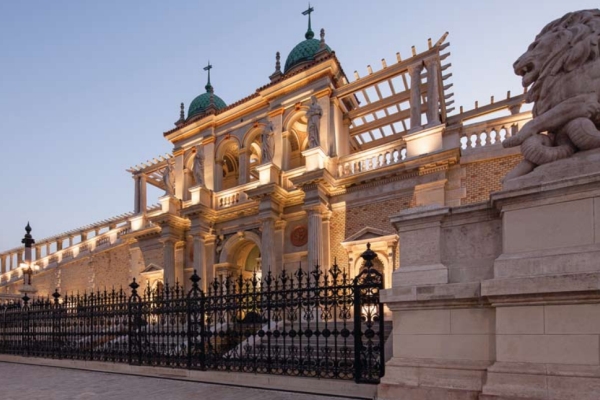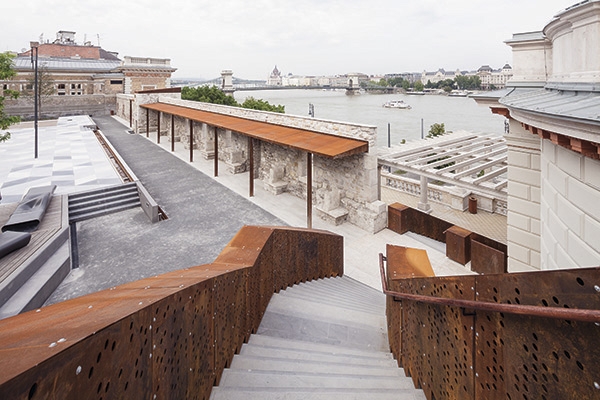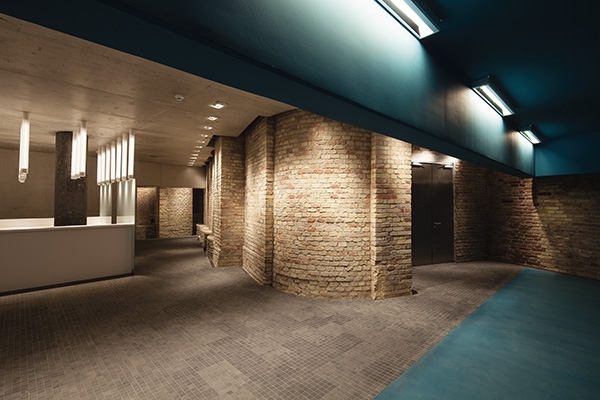Eventful Contradictions
Várkert Bazaar, Budapest
Architects: Ferenc Potzner, Péter Pottyondi, Tamás Dévényi
Text: Anna Zöldi
Photos: Tamás Török / Topogram

Reborn from its ruins, Várkert Bazaar has opened a new gate towards the Castle. Built 130 years ago primarily for aesthetic reasons, this building by Miklós Ybl has been exposed to decay for long decades disgracefully. A precious historic monument has thus survived to escape ultimate decay. Walking inside the building, a citydweller of the 21st century may admire the expertise and tastes of 19th-century architecture. The example of the Bazaar makes us think about what mankind and society may be able to express by leaving man-made marks behind in a world which is perfect without them anyway, and what posterity could do with these marks later on.
The birth and the evolution of the Bazaar, as well as the history of its maintenance, decay and restoration offers us lessons on more than just one level. Back in those days when construction did not need more cause and justification than the pure fact that it could make the environment more attractive it was the most excellent architect and the best masters of the era who were commissioned to create this representative promenade and ramparts lacking genuine functions. As decades passed by, the importance of economical and efficient maintenance came into focus and evolved into a basic criterion, this elaborate architectural work started to deteriorate – which was partly due to the weaknesses and shortages of the materials and technologies used, coupled with the large quantities of rainwater flooding down along the ramparts on the hillside ¬–, much in the same way as it happened to medieval castle walls that also started to decay, the preservation of which is still a burning issue calling for solution today. As the attitude of the protection of historic monuments after 1945 changed, less care was taken of the materials of this eclectic-style edifice, although there was still the ambition to endow it with more useful functions. Converted into a concert venue, Várkert Bazaar actually served public purposes, being useful even though seriously deteriorated. After its closure, the walls started to disintegrate, and there was no sponsoring from the public or private sector to salvage it.
The situation was saved by financiation from the EU which luckily coincided with a political intention ambitioning to use it for representative purposes once again. In its wake, whatever could be restored to its original form was renewed with as much historic authenticity as possible. Learning from the precedents, added values were also created to complete the establishment which may as well facilitate and guarantee its long-term upkeeping. The concept was based on the function of the „gate to the Castle”, in line with which several occasions were created throughout the Bazaar to allow for pedestrian traffic flow between the Danube bank and the Castle. Surrounding the ornate ramp, the ancillary structures were also designed according to this function: the buildings flanking the ramparts from two sides are used now for exhibitions, whilst underground a multi-functional space for events is contained as well as a multi-storey car park to serve tourists who arrive here. Transport is facilitated by elevators as well as by an escalator.

Authentic restoration is a complex task and a challenge from the viewpoints of the protection of historic monuments which has to be presented alongside with additional contemporary values as a whole. Although less of the rusty ironwork would have been enough, we still rate the overall image as an excellent one. Restoration work ambitioned a maximal degree of historic authenticity completed by such peculiarities as the opening of the stairs used for carrying water leading to the tunnel, or the rebuilt arched stairs in the stairs pavilion. Restorers’ work is high standard here which is also proven by the exhibition in the restored southern palace. The system of communication, terraces, ramps, stairs and courtyards tempt us to take a tour of the entire building to discover it as a complex system: every nook here surprises the visitors with exciting visual effects. Placed modestly, contemporary interventions encourage us to walk around. New components multiply the „castle-experience” hidden in our collective subconsciousness, the adventurous experience of walking throughout the zigzagging maze. Architects’/Designers’ attitude here was unambiguous and systematic: every single addition received a cladding made of Corten-sheet. Although the theoretical justification for this may as well be agreed and approved of – rusty sheets shall age naturally and reflect the passage of time accordingly –, viewing the use of this fashionable material in such a quantity and on closer inspection still appears to inspire us. Whether liked or not, rust is not a friendly material, and is more like the metaphor of destructive times than preserving forces. The design of details is of high standards everywhere – ranging from the perforated representations of animal motifs of medieval coat-of-arms to the pierced designs of the stair rails evoking portholes –, but from a tactile proximity this quantity all of a sudden turns out to be oversized. Due to financial reasons, the rivets fixing the plates are no longer rusty ¬- which all in all cannot be rated as disadvantageous for the complex. As the spaces contained are spacious and longitudinally tourable, the overall impression is not a disturbing one, and if we do not have to touch iron, it actually appears a beautifully composed spectacle. Even the statue of Mary belongs to it although it does not seem to be wholly justified based on this context: it still nicely fits on the gable when viewed from a distance. The omnipotence of the Corten-plate is definitely challenged by the boxes for plants made of rusty iron which are placed along the ramps leading up here. Less is actually little here: there should be either more or, more preferably, none of it.

Underground, the events hall and its foyer appear as an independent world: they were designed by Ferenc Potzner and Péter Pottyondy senior designers and interior architect Tamás Dévényi. The foyer spanning behind the ramps blends the past and the future in an exciting way. One of its walls is made up of a brick structure to support the ramps diagonally. The cleansed structures appear as a kind of archaeological findings as well as attractions of a 19th-century building master. The extra spaces thus created house partly would-be exhibitions, partly the rich collection of documents presenting the past of the royal gardens and the iconography of the Bazaar. Exposed concrete surfaces of the foyer are in contrast with the brick structures. Exciting parts of the foyer going beyond trends are representations from chronicles enlarged to cover the entire surface of the opposite wall and the turquoise blue bays of the functional rooms. Elongated in its width, the hall is flanked by a multitude of hanging glass cylinders marking the place of the canteen as futuristic counterpoints of the 19th-century architecture.
An essential part of the whole complex is the landscape design of the gardens and their accessories made by Garten Studio. The Neo-Renaissance garden above the ramps was restored to its original conditions as authentically as possible and is thus able to evoke the former elegance of the architectural complex even in its autumn grandeur. The yard of the house has alway had economic functions, thus the design of which did not limit the architects with the requirements of historic authenticity. This is the freshest point of the stretch of the promenade between the quay and the palace: it is actually a refreshing symbiosis of components of contemporary landscape architecture. Its organically amorphous geometrical slopes and Anjou-checked stone paving adjust it smoothly to the architecture of its surroundings of the 19th century and, at the foot of the Castle walls, of the 21st century. In line with its would-be function, this courtyard shall serve the needs of the younger generation associated with the palace in the north. This obviously contemporary mosaic piece of the complex is actually a link to contemporary uses.
When completed finally, the projected transport lifelines towards the Danube bank and the Pest side of the capital shall present the Castle as a gift to the citydwellers of Budapest. The Bazaar as a guarantee for the survival of the rebuilt 19th century walls shall be the same as in the case of all the relics of the past that have come down to us: the live function and the eternal values they have for the society using them.
Várkert Bazaar reconstruction:
Leading architect: Ferenc Potzner – KÖZTI Zrt.
Architect: Péter Pottyondy – KÖZTI Zrt.
Interiors: Tamás Dévényi – Budapesti Műhely
Landscape: István Steffler – Garten Studio
Building frames: László Horváth – Pataky és Horváth
Structures: Péter Váczi – KÖZTI Zrt. (historical buliding parts), Imre Gurubi – KÖZT Zrt. (new buliding parts), Róbert Gecsényi – Dinám (modified new buliding parts)
HVAC: András Oltvai – Oltvai Studio
Electrical engineering: Máramarosi András – KÖZTI Zrt., Péter Gáspár – GSTR (heavy current), András Ritzl – KÖZTI Zrt. (week current)
Elements of the pedestrian axis leading to the Royal Palace:
Leading architect: Ferenc Potzner – KÖZTI Zrt.
Architect: Ádám Potzner, Orsolya Szabó – KÖZTI Zrt.
Building frames: László Horváth – Pataky és Horváth
Interiors: Kornél Baliga – Korinterni Bt., Tamás Dévényi – Budapesti Műhely Kft.
Landscape: István Steffler – Garten Studio
Structure: Péter Váczi – KÖZTI Zrt. (historical building parts), András Szabó – Ysako Tervező Kft. (new reinforced concrete and steel structures)
Electrical engineering: András Máramarosi – KÖZTI Zrt., Péter Gáspár –GSTR (heavy current), András Ritzl – KÖZTI Zrt. (week current)










